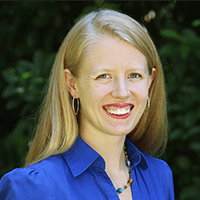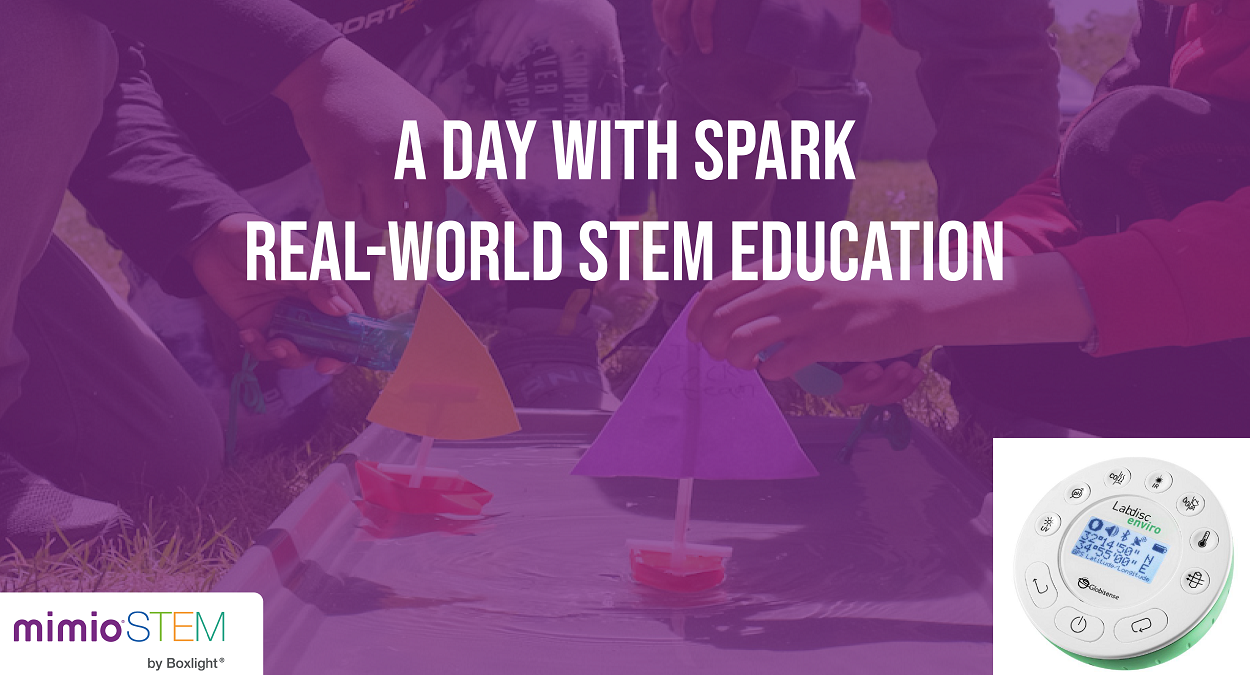
I love being in a classroom that’s engaged in hands-on learning. The combination of excitement, silliness, creativity, and problem-solving all coming together is one of my favorite things. In my role as MimioSTEM product manager, I spend every day developing content and thinking of fun ways to use our technology products in the classroom but it’s always a special treat to get to experience it first-hand.
Earlier this year, Denver Public School’s Spark Exploration Program purchased one of our Mobile STEM Lab solutions designed to bring hands-on learning to life through a combination of our Robo 3D printers, MyBot robots, and Labdisc portable STEM Labs (the Labdisc is essentially a science lab that can be carried in your hand!).
The goal of Spark is to inform students about a range of career opportunities and inspire them to consider careers they may not have known much about before, particularly in science, technology, engineering, art, or mathematics – aka STEM or STEAM. Laura Eley, an Elementary Specialist on the Career Development Team noted, “At the elementary level, it is important to start introducing students to the wide variety of careers that exist in the world. They can begin to form their own career identities and be thinking about their possible future selves and what they hope to learn as they grow.”
One feature of the MimioSTEM solution that stood out to the SPARK program coordinators was its career-focus. All our hardware products include access to MyStemKits, a single sign-on curriculum platform, where teachers can easily find ready-to-use lesson plans featuring student handouts, assessments, and importantly, career connections. These sections of the lesson plan show students how what they’re learning in class applies to the real world and introduces them to a range of possible STEM-related careers.
On May 26th, 2022, seven volunteers from the Gates Corporation* came out to Place Bridge Academy in Denver to introduce a group of students to what they do and help them with some engineering design challenges. Luckily, me and fellow Boxlight trainer Evan Brus, were invited to join and participate as well. The day started with the volunteers each talking a bit about their careers and the students got the chance to share what they knew about mechanical engineers, packing engineers, and even HR and recruitment personnel.
Then, the real fun began. We had two groups of students join us for this special enrichment program. In the first group, a class of third graders was challenged with designing a sail for boats printed in advance using Robo 3D printers. Working as groups, the students had to determine the shape, material, and size of their sail and attach it to their boat using 3D printed connectors and straws. Afterwards, they had to test their boats using simple troughs and hand-held fans.
While students were testing, they were exploring the engineering design process or what is often called in education “Failing Forward,” or seeing fails as a necessary step in progressive learning and reaching success. Students looked at why specific designs didn’t work and brainstormed ways to improve their designs. It was fluid, energetic, and filled with lots of great learning! The Gates volunteers prompted their groups of students with questions intended to help them think through the engineering process. All around me I could hear students thoughtfully considering every aspect of the process. “It kept tipping over, because the straw was too long, so we’re going to cut the straw shorter.” “Oh, the sail isn’t centered on the mast. That’s why it’s falling to that side.” “I don’t think this fan is working well. Let’s try a different one. Oh wow, that’s so much better!” “What if we made it bigger, so it could catch more wind?” “Let’s try a different boat to see if that helps.”
Once each group had finalized a team name and their design, it was off to the races! Groups were organized in brackets so that each group went head-to-head with another group. The winning boat of each race competed in the championship round while the other boats also competed in a second race. Of course, after one final flurry of alterations!
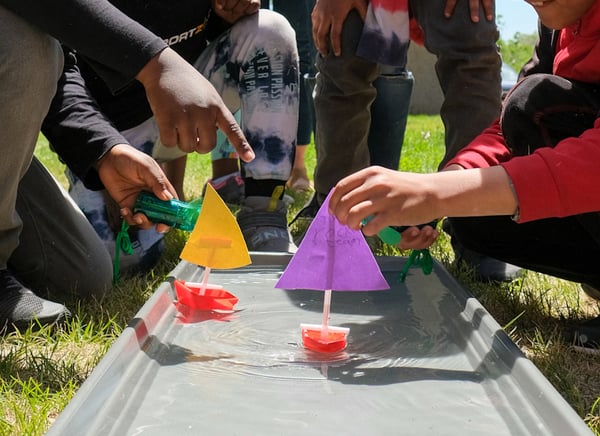
The second group of students to participate was a kindergarten class doing an experiment related to heat and shade. Using a collection of found items, students were tasked with building a shade structure. In advance, students had drawn up designs of different structures that provide shade. They then compared designs with a partner to work together and build something. Every team created something different. Some groups used carboard, others pie pans, while others used paper towel rolls and egg cartons. Some designs looked like futuristic eateries while others resembled works of famous architects. The creativity in the students’ designs was amazing!
Once the designs were finished, we went around asking the students a few questions to prompt their thinking about the science of the experiment. It was a hot day, so we asked them why we were sitting in the shade. That one was easy – because the shade is cooler! Then we asked if we were to measure the temperatures both out in the sun, and out in the sun but under the new structure they’d built, which temperature would be higher (hotter)? All of them guessed that it would be hotter out in the sun.
But a good guess is only a hypothesis until we put it to the test, so the Spark team passed out Labdiscs to the groups. Each group received two Labdiscs so they could test both inside and outside of their structure using the built-in temperature sensor on these portable STEM labs. Eley shared, “The students felt like real scientists using the Labdiscs (because) they were entrusted with real scientific equipment.” Moreover, they loved being able to easily read the value off the Labdisc screen and successfully recognized which temperature was hotter.
Thermometers take a little bit of time to adjust to a new environment so while they were acclimating to the experimental setting, the students got a chance to go around and see how the other groups built their structures. Some groups discovered they needed to make changes once they were in use such as adding newspaper walls because they observed they would block the sun while still letting “the wind” in. Other groups noted they should flip their structures upside down - “the paper will let through more light than the cardboard will, so the paper should go on the bottom instead of the top.” This was engineering in action and it was wonderful to behold! Eley added, “Using the lessons from MyStemKits was immensely helpful for us in planning this event. It saved us so much time in creating our own materials and ensured that each lesson came with a learning objective and outcomes.”

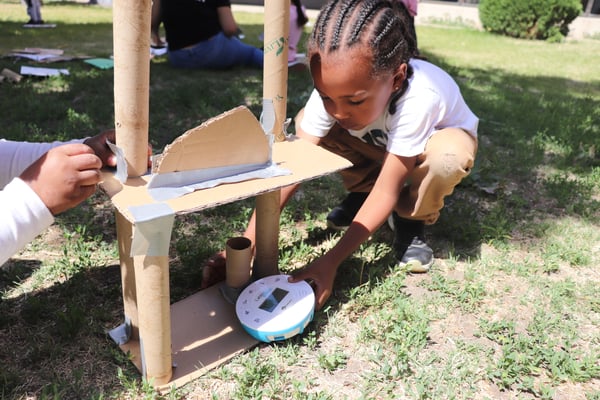
After a few minutes of exploration and discussion, the students went back to their designs to check their results. Sure enough, all the Labdiscs that had been in the shade were significantly cooler than those sitting out in the sun. The students had such a blast building and engineering, all while getting math and science practice (not that they realized it)! At the end, the groups were able to take their structures with them and they all ran over to grab their creations.
This is the kind of day that students remember because these are the kind of activities that make learning seem like playing. These experiences help rejuvenate and inspire me every day to keep coming up with fun ways to learn and to teach.
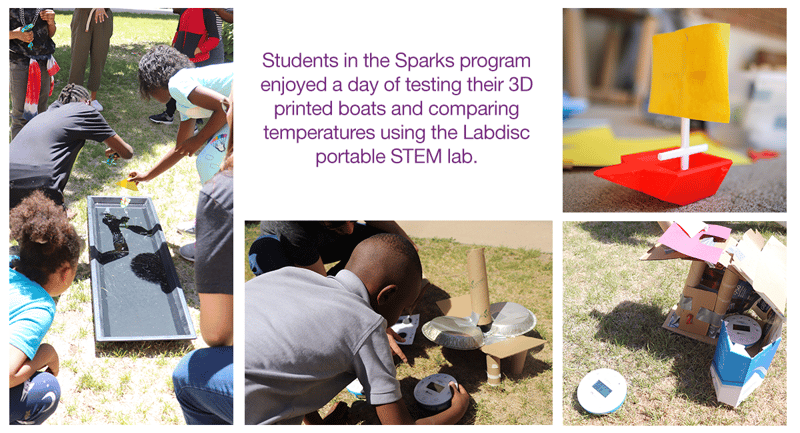
I want to say a special thank you to Denver Public School’s Spark Exploration Program for inviting us to be a part of this amazing event. I’d also like to thank the Gates Corporation and Gates Family Foundation for providing funds so that these students will be able to have experiences like this not just one day a year, but as part of their regular instruction.
*An essential aspect of Spark is partnering with Denver metro-area businesses such as the Gates Corporation. The Gates Corporation is a leading manufacturer of application-specific fluid power and power transmission solutions and has been in Denver since its founding in 1911. Giving back has been a core tenant of their philosophy since 1946 when the Gates Family Foundation was started, and the purchase of the Mimio Mobile STEM Lab was made possible due to a generous grant from the Foundation.
The activities completed on this exploration day were adaptations of the following:
- Sail Shapes and Materials (grade 2)
- Shade Structures (grade K)
Both lessons are available on www.MyStemKits.com. Get started with a free trial!
To explore Boxlight’s award-winning solutions, including award-winning MimioSTEM solutions, go to www.boxlight.com.

